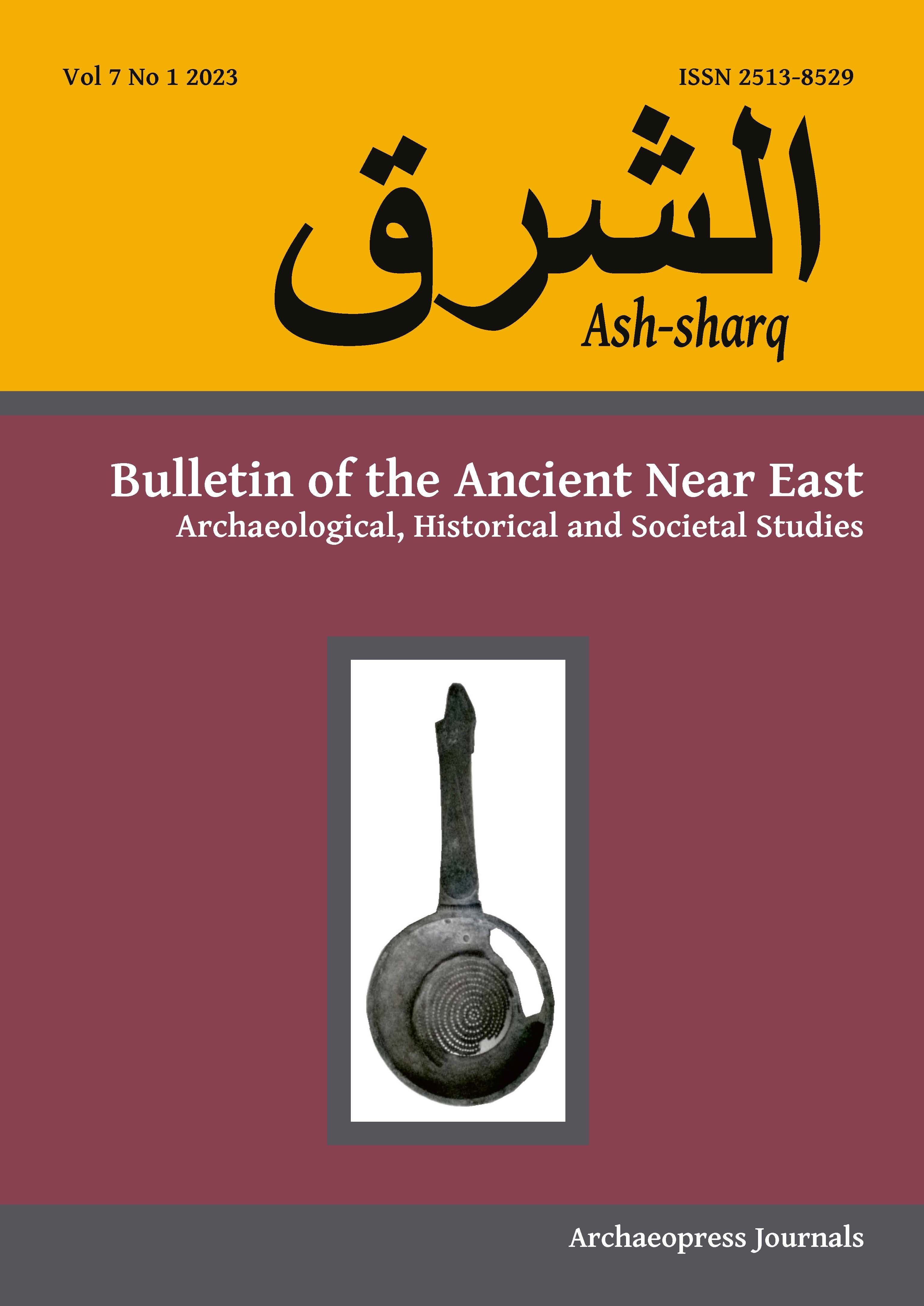From Jemdet Nasr origins to an early Muslim town in the wetlands: second preliminary report on excavations at Kobeba (Dhi Qar governorate), southern Iraq
Keywords:
Kobeba, Jemdet NasrAbstract
In 2022, targeted excavations were carried out as part of a study season at the site of Kobeba, near the town of al-Rifa’i, in Dhi Qar governorate, southern Iraq. The results were very successful and clarified a number of outstanding questions over the dating and phasing. One sounding has confirmed a deep sequence of Jemdet Nasr occupation with evidence for pottery production and a fragment of a jar with part of a carefully incised pictographic inscription. A second sounding has gone below the latest two levels of 8th century early Islamic occupation to reach a third level with more substantial architecture datable to the 7th century, and a Sasanian level below that. This sequence is now one of the most important for these periods from Iraq and there are clear changes in the pottery which will help future surveys in this region. Finally, a test trench excavated last year in the fields beyond the site was expanded into a larger area, and the results proved that there is an archaeological layer contemporary with the latest period of occupation at Kobeba at a depth of 1.60 m below plain level and resting directly on top of an ancient marsh deposit: this proves that at this period Kobeba was in a wetland environment very different to the present situation.
References
Alden, J.R. 1988. Ceramic Ring Scrapers: an Uruk period pottery production tool. Paléorient 14/1: 143–50.
Baghdad 1979. Atlas of Archaeological Sites in Iraq. Baghdad: al-Huria Printing House / al-Jumhuriya Press.
Benati, G. 2019. Shaping social dynamics in early 3rd millennium BC Mesopotamia: Solid-footed goblets and the politics of drinking, in M. D’Andrea, M.G. Micale, D. Nadali, S. Pizzimenti and A. Vacca (eds) Pearls of the Past: Studies on Near Eastern Art and Archaeology in Honour of Frances Pinnock (Marru 8): 53–76. Münster: Zaphon.
Brouwer, M. 1991. Rijksmuseum van Oudheiden. Glasuit de Oudheid. Amsterdam: de Bataafsche Leeuw.
Ciuk, C. 2000. Pottery from Parthian, Sasanian, and Early Islamic levels at Nippur, Iraq 1st–9th centuries A.D. Bulletin of the Canadian Society for Mesopotamian Studies 35: 57–79.
Connan, J., C. Breniquet and J.-L. Huot 1996. Les objets bituminés de Tell el Oueili des témoins de la diversité des réseaux d’échanges commerciaux de l’Obeid O à l’Uruk récent, in J.-L. Huot (ed.) Oueili. Travaux de 1987 et 1989 (Bibliothèque de la Délégation Archéologique Française en Iraq 8): 413–30. Paris: Editions Recherche sur les Civilisations.
Demange, F. (ed.) 2006. Les Perses sassanides. Fastes d’un empire oublié (224–642). Paris, Editions Findakly.
Finster, B. and J. Schmidt 1976. Sasanidische and frühislamische Ruinen im Iraq. Baghdader Mitteilungen 8: 57–150.
Fukai, S. 1977. Persian Glass. New York / Tokyo / Kyoto: Weatherhill / Tankosha (translated by E.B. Crawford).
Mackay, E. 1931. Report on Excavations at Jemdet Nasr, Iraq (Anthropology Memoirs I/3). Chicago: Field Museum of Natural History.
Marchetti, L., M. Campeggi, C. D’Orazio, V. Gallerani, G. Giacosa, A. Al-Hussainy, G. Luglio, S. Mantellini, E. Mariani, J. Monastero, M. Valeri and F. Zaina 2020. The Iraqi-Italian QADIS project: Report on six seasons of integrated survey. Sumer 66: 177–217.
Martin, H. 1983. Settlement Patterns at Shuruppak. Iraq 45/1 spring): 24–31.
Matthews, R. 1997. After the archive: Early Dynastic I occupation at Jemdet Nasr, Iraq. Al-Rafidan 18: 109–17.
Matthews, R. 2002. Secrets of the Dark Mound. Jemdet Nasr 1926–1928 (Iraq Archaeological Reports 6). Warminster [UK]: British School of Archaeology in Iraq / Aris & Phillips.
Meyer, C. 2021. Islamic and Pre-Islamic glass from Nippur. Bulletin of the American Schools of Oriental Research 386 (November): 133–75.
Pollock, S. 1990. Political economy as viewed from the garbage dump: Jemdet Nasr occupation at the Uruk Mound, Abu Salabikh. Paléorient 16/1: 57–75.
Pollock, S. 2017. Making fire in Uruk-Period Abu Salabikh, in Y. Heffron, A. Stone and M. Worthington (eds) At the Dawn of History: Ancient Near Eastern Studies in Honour of J.N. Postgate: 413–20. Winona Lake [IN]: Eisenbrauns.
Simpson, St J. 2008. Suburb or slum? Excavations at Merv (Turkmenistan) and observations on stratigraphy, refuse and material culture in a Sasanian city, in D. Kennet and P. Luft (eds) Recent Advances in Sasanian Archaeology and History (British Archaeological Reports, International Series 1248): 65–78. Oxford: Archaeopress.
Simpson, St J. 2021a. Tulul Kobeba (Dhi-Qar province). Report on archaeological investigations carried out by the British Museum, October–December 2021. Sumer 67: 63–79.
Simpson, St J. 2021b. Tulul Kobeba: First results of survey and excavation at a looted early medieval ‘marsh Arab’ township in Dhi-Qar province, southern Iraq. ash-Sharq 6: 4–57.
Simpson, St J. 2022. Kobeba. Report on archaeological investigations carried out by the British Museum, November–December 2022. Sumer in press.
Steve, M.-J. and H. Gasche 1971. L’acropole de Suse. Nouvelles fouilles (rapport préliminaire) (Mémoires de la Délégation Archéologique en Perse 46). Leiden: E.J. Brill / Paris: Paul Geuthner.
Venco Ricciardi, R. 1973/74. Trial trench at Tell Baruda (Choche). Mesopotamia 8/9: 15–20, figs 11–16.
Venco Ricciardi, R. 1977. Trial trench at Tell Baruda, Choche (1975). Mesopotamia 12: 11–14.
Whitehouse, D. 1980. Siraf III: The Congregational Mosque, and Other Mosques from the Ninth to the Twelfth Centuries. London: The British Institute of Persian Studies.
Whitehouse, D. 1984. The smaller mosques at Sīrāf: A footnote. Iran 22: 166–68.


